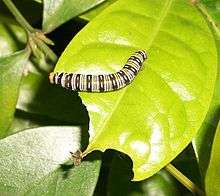Hawaan Forest
The Hawaan Forest is situated in Umhlanga, KwaZulu-Natal, South Africa. It is a large remnant of a climax dry coastal dune forest and the last of its kind.[1] This forest grows on a dune that dates back 18,000 years.[2] The Hawaan forest is currently under the guardianship of the Wildlife and Environment Society of Southern Africa (WESSA), but is owned by the Tongaat Hulett Group.[1] The property was originally owned by the Campbell family who first settled there in 1859 and the Hawaan Forest has been protected since 1860.[3] The Hawaan Forest Estate is known for being one of the most exclusive estates in the country.
Etymology
The origin of the name Hawaan is obscure. This is not an isiZulu word, and the closest words in isiZulu are hawe usually used as hawe ma and used as an exclamation of surprise or disappointment, and ihawu meaning "small shield". Neither of these words seem appropriate as an origin for the name Hawaan. It has been suggested that the name stems from indentured Indian labourers who were brought to South Africa to work on sugar-cane plantations. Much of the area surrounding Hawaan Forest was sugar-cane plantations, and it is thought that the Indian labourers who practiced Hinduism used the forest for religious ceremonies, particularly those associated with Havan. A Havan is a sacred purifying ritual in Hinduism that involves a fire ceremony and is a ritual of sacrifice made to the Fire god, Agni. The vessel used to perform the havan is called the Ôhavan kund.[4] After the fire is lit in the Ôhavan kund, things such as fruits, honey and wooden goods are placed in the sacred fire. It is thought that the forest now known as the Hawaan Forest was a source of fruits, honey and wood to be used in the Havan ceremonies and that the forest was thus called Havan or Hawan, now Hawaan.
I lived in Burnside estate which is a 30 minute walk from havaan forest.Where the old Umdhloti road ran close to the forest edge there was an old Zulu settlement which was known as Stormy Village perhaps because of the loud drums played there.Opposite this settlement was a domestic waste site which serviced the Umhlanga village. Adjacent to this tip site there was an area that had deteriorated old oyster shells a layer of about 300mm. There must have been a settlement here. In the 60 s my friends and I used to frequent this place mostly searching the tip site for any items that we might be able to re use.
I have lived with and had conversations with some first generation siblings in my young days and there was no indication that Indians ever associated themselves religiously to the forest name. In fact most of my estate people never frequented this place. I remember going to this bush to collect mangoes and guava to sell at the durban morning market. There was a track from stormy village leading to the river.
We used to fish for mud breams at a spot called red sands because of the colour of the soil. There is so much to tell about this and the Umhlanga village.[5]
Wildlife

The Hawaan Forest is home to various wildlife, the largest of which include; bushbuck, red duiker, blue duiker, bushpig, African rock python and crowned eagle.[6] Other smaller species found here include the KwaZulu dwarf chameleon, coast purple tip butterfly, and the forest dwelling millipedes: Ulodesmus spiralipes, Centrolobus anulatus, Spinotarsus lobatus and Doratogonus cristulatus.[6] Birds include the crested guineafowl and endangered spotted ground-thrush.[6]
Hawaan Forest Estate
The Hawaan Forest Estate covers 157 acres (64 ha) and has been meticulously planned and designed with the help of architect Stefan Antoni and indigenous gardener, Geoff Nichols, who has complemented this with his horticultural expertise and understanding of the neighbouring forest.
All properties are strategically placed, affording them corridor views towards forest and ocean, while gardening is strictly indigenous and homeowners have a list of 600 plants from which to choose when planting on each property. No pets are allowed on the estate, a necessary sacrifice to protect the birds and wildlife.
References
- Hawaan Forest - Umhlanga http://www.wheretostay.co.za/information/topic/3266, retrieved 22 November 2010.
- Hawaan Forest: Fodor’s review http://www.fodors.com/world/africa-and-middle-east/south-africa/durban-and-kwazulu-natal/review-471380.html, retrieved 22 November 2010.
- Pooley & Player 1995.
- "Metaphysical Techniques: Havan and Yagya: Procedure for purification". Archived from the original on June 5, 2013. Retrieved 2010-11-23.CS1 maint: BOT: original-url status unknown (link)
- Moll, E. J. (1969-11-14). "An Investigation of the Plant Ecology of the Hawaan Forest, Natal, using an Ordination Technique". Bothalia. 10 (1): 121–128. doi:10.4102/abc.v10i1.1524. ISSN 2311-9284.
- Nichols, G. (May 2003). HAWAAN FOREST ESTATE: ENVIRONMENTAL IMPACT ASSESSMENT REPORT: DESIGN DEVELOPMENT
- Pooley, Tony; Player, Ian (1995). KwaZulu/Natal Wildlife Destinations: A Guide to the Game Reserves, Resorts, Private Nature Reserves, Ranches, and Wildlife Areas of KwaZulu/Natal. Southern Book Publishers. ISBN 978-1-86812-487-9.CS1 maint: ref=harv (link)